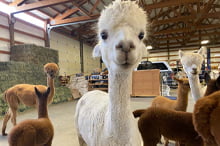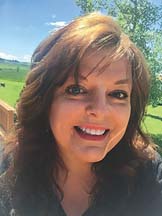No products in the cart.
Big Brown Eyes

At the Alpaca Farm
Story and Photos by Lorie Palmer
A few years ago, when my husband and I were out for a drive from Grangeville, we ambled down rural Talmaks Road off U.S. Highway 95 just west of Craigmont. Several miles in, I saw tufted heads peeking above the landscape. We drove slowly by a sign that read, “Sweet Pine Alpacas.”
Craigmont is only about thirty-one miles northwest of Grangeville but it’s in Lewis County, which is out of my jurisdiction as a reporter over the past three decades for the Idaho County Free Press. That’s why I had never seen this farm.
When I contacted owner Carol Vernay, she and husband Bob were warm and welcoming, as was their grown-up daughter, Brandy Henson. Brandy and her husband Chad also have a herd, which is housed together on the farm with her parents’ animals.
When I entered an open bay filled with mothers and their cria or offspring, the dogs Paca and Mari kept dutiful watch. Mari, a blend of the Tatra shepherd dog of Poland, the Spanish mastiff, and the Maremma sheepdog of Italy, stood nearly as tall as several of the alpacas. “He has a commanding bark,” Bob said, “and they listen if he warns them. And he listens if they warn him of something.”
This content is available for purchase. Please select from available options.
Register & Purchase Purchase Only
Register & Purchase Purchase Only

